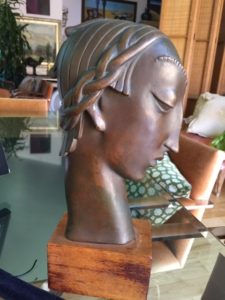 JF sent me a deco style metal sculpture bust of a young male. I presume it’s Apollo from the laurel leaf crown around his head. I don’t see any markings of attributions, except for a small paper label stating #2017. My challenge became to figure out the artist without a signature, and perhaps the year of creation.
JF sent me a deco style metal sculpture bust of a young male. I presume it’s Apollo from the laurel leaf crown around his head. I don’t see any markings of attributions, except for a small paper label stating #2017. My challenge became to figure out the artist without a signature, and perhaps the year of creation.
I sent JF’s photos to the most significant gallery for this era of Austrian sculpture, the Galerie Hagenauer Wien. So we’ll see if I’m right that this is third quarter 20th century Austrian. An appraiser figures out a challenge like this by knowing period design.
Werkstatte Design
I guessed at one of the Hagenaurer family because I experienced the great fortune of studying Wiener Werkstatte architecture in Vienna. I fell in love with the architecture of Josef Hoffman (1870-1956) whose Werkstatte style influenced the modernists of the 1920’s. In fact architecture significantly and traditionally influences metalwork of all kinds, including sculpture and jewelry. Werkstatte design opened the door to modernism. We see it in architecture and metalwork first.
By the 1930’s Viennese style took under its wing French and Italian Deco designs. Sculpting throughout Europe from this period contains two distinct elements: Classicism and Exoticism. For less ‘important’ craft pieces in metal, artist tended towards whimsical animals.
Influential Hagenauer Metalworkers of Vienna
Karl Hagenauer was a second generation sculptor whose father Carl opened his Werkstatte in 1898. WWI bankrupted his workshop, and his son. Karl returned from the war to took over the shop at the age of 20. Perhaps because of his youth Karl absorbed the shapes of Jugendstil and Art Deco, with naturalistic flowing lines and themes tending towards surrealism.
No aesthete, Karl didn’t fear popularism. He created small affordable brass and wood figures of animals in purchasable shapes. These included lamps, candlesticks, trays, bookends, and hood ornaments. An important animal of the era, the horse, along with the stylized dog, featured in many designs.
Karl’s younger brother Franz Hagenauer joined the firm to draw busts from which he made wax models. These models created the negative in a sand casting. Once the bronze cooled, they chiseled and polished the casting, and mounted it on a plain wood base. Because of the size and the classical figure of a beautiful young Apollo on JF’s sculpture, I believe this must be the design of Franz.
But research tell us others copied these figures because of their relatively small size and simplified lines. The beauty of the piece lies in its simplicity, and of course the style. We don’t see much Deco design in California, but this piece reminds us of how earth-shattering the Deco period became in art history.
Hagenaurer Family Goes Retail
With no retail store Karl exhibited at the phenomena we might never see again on this newly infected planet called the World’s Fair. He caught the attention of Rena Rosenthal, a high-end Manhattan shopkeeper, and John Wannamaker, the department store mogul of NY and Philadelphia. Hagenauer exports became plentiful in the 1920’s and 1930’s, continuing on to the 1950’s with a more whimsical line of work. Karl and Fritz opened their own retail shop in in 1938, for which Karl invented a special patination for brass.
In the 1950-60’s their sculptures took on the abstracted lines of African sculpture, and in the 1970’s the shop reproduced some of Franz’ busts. SO I’m not sure if I should set a date of 1930 or 1970 to JF’s bust.
Karl’s son Karl opened his own shop in 2001, in one of the former locations of the Hagenaurer Werkstatte, long after the firm disbanded, to collect and sell Hagenauer works. Karl’s son, the founder’s grandson, expanded the inventory of works sold at the gallery to those by the great Austrian designers of the 1920’s and through the most formative period of the Werkstatte movement. I wrote to them to ask the value of your bust, and who made it. If I am guessing right it’s by Fritz Hagenauer. One similar to yours sold at auction for $3,750 recently.
Great department store Wanamaker’s. Grew up outside Philly and going to lunch there, hanging out at the ‘eagle’. Such fond memories!